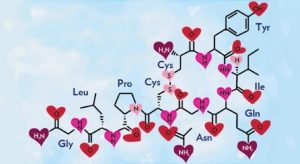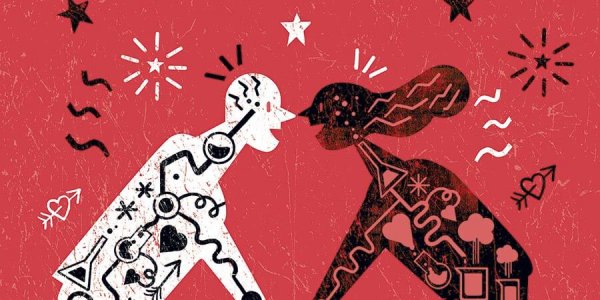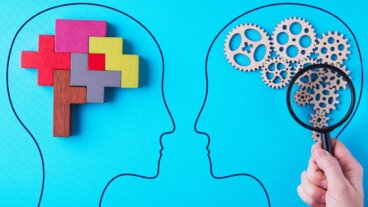Oxytocine, het hormoon van liefde en geluk


Geschreven en geverifieerd door de psycholoog Gema Sánchez Cuevas
Oxytocine is een hormoon met verschillende functies. We weten nog steeds niet precies wat veel hiervan zijn. Maar we weten bijvoorbeeld wel dat oxytocine het hormoon is dat ons verbindt met andere mensen.
Het injecteert ons met een bepaalde kracht die een rol speelt in affectie, reproductie, lactatie en liefde in al haar vormen en kleuren. Het induceert een bevalling en geeft vorm aan het leven met een hoofdletter L.
Als we het hebben over oxytocine, zijn er in onze huidige wereld veel mensen die het bijna onmiddellijk associëren met die andere vorm van oxytocine. De synthetische vorm, die weeën induceert.
Oxytocine wordt geproduceerd in onze hypothalamus en komt vrij vanuit onze hypofyse.
Onderzoek naar deze minuscule organische molecule, zowel hormoon als neurotransmitter, blijft doorgaan. Nog maar een paar maanden geleden onthulde het wetenschappelijke tijdschrift ‘Social Cognitive and Affective Neuroscience‘ de rol die oxytocine kan spelen op mentaal niveau, als het gaat om het bevorderen van ontspanning, rust en processen die bijvoorbeeld meditatie in gang zetten.
Om het anders te zeggen: oxytocine verbindt ons niet alleen met anderen. Het stimuleert ook psychologische en emotionele mechanismen die ons helpen om ons beter met onszelf te verbinden. Het heeft te maken met het interne evenwicht.
Nu we een aantal functies hebben geschetst en verteld hebben hoe belangrijk het is, gaan we proberen om dit ongelooflijke hormoon, oxytocine, beter te leren kennen.

Oxytocine, het hormoon van de liefde en meer…
Oxytocine is een oligopeptide die bestaat uit negen aminozuren. Het werd ontdekt aan het begin van de vorige eeuw en werd kunstmatig gesynthetiseerd door de biochemicus Vincent Du Vigneaud in 1953.
Dat was toen deze stof, zo krachtig en belangrijk in onze hersenen, onder de loep werd genomen. Het doel was om de rol te identificeren die het speelde in belangrijke delen van ons leven, zoals sociale relaties.
Nu weten we dat deze chemische stof de motor is die aan wordt gezet en veel van ons sociale gedrag vormgeeft. Dingen als empathie, vertrouwen, vriendschap, vrijgevigheid of altruïsme.
Ook heeft het een belangrijke functie in ons beloningscentrum dat geprikkeld wordt door dopamine. Het is oxytocine dat bijvoorbeeld plezier genereert tijdens orgasmen.
En dus, gezien deze kenmerken, zullen mensen aannemen dat het verantwoordelijk is voor die echt intense, belangrijke relaties.
Maar zoals ze uitleggen in een artikel in het tijdschrift ‘Neuroscience and Biobehavioral Reviews’, is dit laatste veel complexer dan we op het eerste gezicht denken.
Want in affectieve relaties is er veel meer aan de hand. Er zijn veel verschillende dynamica in de cocktail van neurotransmitters die oxytocine bevatten.

Als we verliefd zijn en we die intense, gekke, bijna obsessieve passie voelen, verlaagt oxytocine eigenlijk onze remmingen. Wetenschappers zeggen dat dit hormoon een effect heeft op onze neurale circuits op een manier die vergelijkbaar is met die van alcohol.
Het moedigt ons aan om risico’s te nemen, op onszelf te vertrouwen en mogelijke gevaren of implicaties van de relatie te negeren. Zelfs als het schadelijk is. Zelfs als het giftig is.
Sommigen kunnen dit de ‘duistere’ kant van oxytocine noemen. Maar het maakt het wel interessanter.
Oxytocine, de facilitator van het leven
Oxytocine reguleert generositeit, zorgzaamheid, vertrouwen en mededogen. Als dit zo is, is het niet moeilijk te zien waarom mensen het het ‘menselijk hormoon’ noemen.
Maar we mogen één zeer belangrijk feit niet vergeten. Zelfs in het dierenrijk zorgen moeders voor en verdedigen zij hun nakomelingen tot aan de dood. Oxytocine reguleert ook hun gedrag. Eigenlijk weten we dat mensen en honden door dit hormoon prachtige verbindingen kunnen hebben.
“Ogen zullen geen hulp bieden aan een blind hart.”
-Arabisch spreekwoord-
Dus, in plaats van het alleen maar het menselijk hormoon te noemen, zouden we het vanuit een breder en belangrijker perspectief moeten zien. Als facilitator van het LEVEN, volledig in hoofdletters.
Want het stelt ons in staat om contact te leggen met elkaar, met andere soorten, met onze omgeving en zelfs met onszelf. Het vergemakkelijkt het samenleven. We begrijpen dat genegenheid, altruïsme, zorgzaamheid en zelfzorg overleving garanderen.

Ook wordt er op dit moment een nieuw aspect bestudeerd en dit is heel interessant. Er is ontdekt dat oxytocine onze aandacht voor de sociale en emotionele informatie in onze omgeving verhoogt.
Het helpt ons om te interpreteren welke stimuli belangrijk zijn. Op deze manier kunnen we ze onthouden, interpreteren en verwerken. Ook hier hebben we weer die ‘verbinding’. Die kracht die ons uitnodigt om ons te verbinden met wat ons omringt. Om je deelnemer te voelen, een deel van een geheel.
Deze bevinding zou significant kunnen zijn voor mensen met Autisme Spectrum Stoornis (ASS). In feite hebben ze aangetoond dat een oxytocinetekort kan bijdragen aan het ontstaan van autisme.
Daarom zijn de eerste klinische proeven begonnen om hun sociale integratie en interactie te verbeteren. Laten we hopen dat het werkt. Laten we ook hopen dat er steeds meer ontdekt wordt over deze geweldige molecule.
Bibliografie
-Kerstin Uvnäs Moberg (2003) “The Oxytocin Factor: Tapping the Hormone of Love, Calm, and Healing”. Da Capo Press.
Oxytocine is een hormoon met verschillende functies. We weten nog steeds niet precies wat veel hiervan zijn. Maar we weten bijvoorbeeld wel dat oxytocine het hormoon is dat ons verbindt met andere mensen.
Het injecteert ons met een bepaalde kracht die een rol speelt in affectie, reproductie, lactatie en liefde in al haar vormen en kleuren. Het induceert een bevalling en geeft vorm aan het leven met een hoofdletter L.
Als we het hebben over oxytocine, zijn er in onze huidige wereld veel mensen die het bijna onmiddellijk associëren met die andere vorm van oxytocine. De synthetische vorm, die weeën induceert.
Oxytocine wordt geproduceerd in onze hypothalamus en komt vrij vanuit onze hypofyse.
Onderzoek naar deze minuscule organische molecule, zowel hormoon als neurotransmitter, blijft doorgaan. Nog maar een paar maanden geleden onthulde het wetenschappelijke tijdschrift ‘Social Cognitive and Affective Neuroscience‘ de rol die oxytocine kan spelen op mentaal niveau, als het gaat om het bevorderen van ontspanning, rust en processen die bijvoorbeeld meditatie in gang zetten.
Om het anders te zeggen: oxytocine verbindt ons niet alleen met anderen. Het stimuleert ook psychologische en emotionele mechanismen die ons helpen om ons beter met onszelf te verbinden. Het heeft te maken met het interne evenwicht.
Nu we een aantal functies hebben geschetst en verteld hebben hoe belangrijk het is, gaan we proberen om dit ongelooflijke hormoon, oxytocine, beter te leren kennen.

Oxytocine, het hormoon van de liefde en meer…
Oxytocine is een oligopeptide die bestaat uit negen aminozuren. Het werd ontdekt aan het begin van de vorige eeuw en werd kunstmatig gesynthetiseerd door de biochemicus Vincent Du Vigneaud in 1953.
Dat was toen deze stof, zo krachtig en belangrijk in onze hersenen, onder de loep werd genomen. Het doel was om de rol te identificeren die het speelde in belangrijke delen van ons leven, zoals sociale relaties.
Nu weten we dat deze chemische stof de motor is die aan wordt gezet en veel van ons sociale gedrag vormgeeft. Dingen als empathie, vertrouwen, vriendschap, vrijgevigheid of altruïsme.
Ook heeft het een belangrijke functie in ons beloningscentrum dat geprikkeld wordt door dopamine. Het is oxytocine dat bijvoorbeeld plezier genereert tijdens orgasmen.
En dus, gezien deze kenmerken, zullen mensen aannemen dat het verantwoordelijk is voor die echt intense, belangrijke relaties.
Maar zoals ze uitleggen in een artikel in het tijdschrift ‘Neuroscience and Biobehavioral Reviews’, is dit laatste veel complexer dan we op het eerste gezicht denken.
Want in affectieve relaties is er veel meer aan de hand. Er zijn veel verschillende dynamica in de cocktail van neurotransmitters die oxytocine bevatten.

Als we verliefd zijn en we die intense, gekke, bijna obsessieve passie voelen, verlaagt oxytocine eigenlijk onze remmingen. Wetenschappers zeggen dat dit hormoon een effect heeft op onze neurale circuits op een manier die vergelijkbaar is met die van alcohol.
Het moedigt ons aan om risico’s te nemen, op onszelf te vertrouwen en mogelijke gevaren of implicaties van de relatie te negeren. Zelfs als het schadelijk is. Zelfs als het giftig is.
Sommigen kunnen dit de ‘duistere’ kant van oxytocine noemen. Maar het maakt het wel interessanter.
Oxytocine, de facilitator van het leven
Oxytocine reguleert generositeit, zorgzaamheid, vertrouwen en mededogen. Als dit zo is, is het niet moeilijk te zien waarom mensen het het ‘menselijk hormoon’ noemen.
Maar we mogen één zeer belangrijk feit niet vergeten. Zelfs in het dierenrijk zorgen moeders voor en verdedigen zij hun nakomelingen tot aan de dood. Oxytocine reguleert ook hun gedrag. Eigenlijk weten we dat mensen en honden door dit hormoon prachtige verbindingen kunnen hebben.
“Ogen zullen geen hulp bieden aan een blind hart.”
-Arabisch spreekwoord-
Dus, in plaats van het alleen maar het menselijk hormoon te noemen, zouden we het vanuit een breder en belangrijker perspectief moeten zien. Als facilitator van het LEVEN, volledig in hoofdletters.
Want het stelt ons in staat om contact te leggen met elkaar, met andere soorten, met onze omgeving en zelfs met onszelf. Het vergemakkelijkt het samenleven. We begrijpen dat genegenheid, altruïsme, zorgzaamheid en zelfzorg overleving garanderen.

Ook wordt er op dit moment een nieuw aspect bestudeerd en dit is heel interessant. Er is ontdekt dat oxytocine onze aandacht voor de sociale en emotionele informatie in onze omgeving verhoogt.
Het helpt ons om te interpreteren welke stimuli belangrijk zijn. Op deze manier kunnen we ze onthouden, interpreteren en verwerken. Ook hier hebben we weer die ‘verbinding’. Die kracht die ons uitnodigt om ons te verbinden met wat ons omringt. Om je deelnemer te voelen, een deel van een geheel.
Deze bevinding zou significant kunnen zijn voor mensen met Autisme Spectrum Stoornis (ASS). In feite hebben ze aangetoond dat een oxytocinetekort kan bijdragen aan het ontstaan van autisme.
Daarom zijn de eerste klinische proeven begonnen om hun sociale integratie en interactie te verbeteren. Laten we hopen dat het werkt. Laten we ook hopen dat er steeds meer ontdekt wordt over deze geweldige molecule.
Bibliografie
-Kerstin Uvnäs Moberg (2003) “The Oxytocin Factor: Tapping the Hormone of Love, Calm, and Healing”. Da Capo Press.
Alle siterte kilder ble grundig gjennomgått av teamet vårt for å sikre deres kvalitet, pålitelighet, aktualitet og validitet. Bibliografien i denne artikkelen ble betraktet som pålitelig og av akademisk eller vitenskapelig nøyaktighet.
- Carter, C. S. (2022). Oxytocin and love: myths, metaphors and mysteries. Comprehensive Psychoneuroendocrinology, 9, 1-10. https://www.ncbi.nlm.nih.gov/pmc/articles/PMC9216351/
- Carter, C. S., & Porges, S. W. (2013). The biochemistry of love: an oxytocin hypothesis. EMBO reports, 14(1), 12-16. https://www.ncbi.nlm.nih.gov/pmc/articles/PMC3537144/
- Cera, N., Vargas-Cáceres, S., Oliveira, C., Monteiro, J., Branco, D., Pignatelli, D., & Rebelo, S. (2021). How relevant is the systemic oxytocin concentration for human sexual behavior? A systematic review. Sexual Medicine, 9(4), 100370-100370. https://www.ncbi.nlm.nih.gov/pmc/articles/PMC8360917/
- Cleveland Clinic. (March 27, 2022). Oxytocin. Consultado el 6 de julio de 2023. https://my.clevelandclinic.org/health/articles/22618-oxytocin#:~:text=What%20is%20the%20function%20of,aid%20in%20lactation%20after%20childbirth.
- Cochran, D., Fallon, D., Hill, M., & Frazier, J. A. (2013). The role of oxytocin in psychiatric disorders: a review of biological and therapeutic research findings. Harvard review of psychiatry, 21(5), 219-247. https://www.ncbi.nlm.nih.gov/pmc/articles/PMC4120070/
- DeAngelis, T. (2008). The two faces of oxytocin. American Psychological Association. Consultado el 6 de julio de 2023. https://www.apa.org/monitor/feb08/oxytocin
- Hashimoto, H., Uezono, Y., & Ueta, Y. (2012). Pathophysiological function of oxytocin secreted by neuropeptides: a mini review. Pathophysiology, 19(4), 283-298. https://www.sciencedirect.com/science/article/abs/pii/S0928468012000831?via%3Dihub
- Haynes, A. C., Lywood, A., Crowe, E. M., Fielding, J. L., Rossiter, J. M., & Kent, C. (2022). A calming hug: Design and validation of a tactile aid to ease anxiety. Plos one, 17(3), 1-26. https://journals.plos.org/plosone/article?id=10.1371/journal.pone.0259838
- Ito, E., Shima, R., & Yoshioka, T. (2019). A novel role of oxytocin: Oxytocin-induced well-being in humans. Biophysics and physicobiology, 16, 132-139. https://www.ncbi.nlm.nih.gov/pmc/articles/PMC6784812/
- Jayaram, N., Varambally, S., Behere, R. V., Venkatasubramanian, G., Arasappa, R., Christopher, R., & Gangadhar, B. N. (2013). Effect of yoga therapy on plasma oxytocin and facial emotion recognition deficits in patients of schizophrenia. Indian journal of psychiatry, 55(Suppl 3), 409-413. https://www.ncbi.nlm.nih.gov/pmc/articles/PMC3768223/
- Jones, C., Barrera, I., Brothers, S., Ring, R., & Wahlestedt, C. (2022). Oxytocin and social functioning. Dialogues in clinical neuroscience, 19(2), 193-201. https://www.ncbi.nlm.nih.gov/pmc/articles/PMC5573563/#:~:text=A%20plethora%20of%20studies%20have,%2C%20and%20anxiety%2C%20among%20others.&text=Oxytocin%20acts%20centrally%20within%20the,role%20in%20parturition%20and%20lactation.
- Keeler, J. R., Roth, E. A., Neuser, B. L., Spitsbergen, J. M., Waters, D. J. M., & Vianney, J. M. (2015). The neurochemistry and social flow of singing: bonding and oxytocin. Frontiers in human neuroscience, 518, 1-10. https://www.frontiersin.org/articles/10.3389/fnhum.2015.00518/full#h4
- Kirsch, P., Esslinger, C., Chen, Q., Mier, D., Lis, S., Siddhanti, S., & Meyer-Lindenberg, A. (2005). Oxytocin modulates neural circuitry for social cognition and fear in humans. Journal of neuroscience, 25(49), 11489-11493. https://pubmed.ncbi.nlm.nih.gov/16339042/
- Lawson, E. A., Olszewski, P. K., Weller, A., & Blevins, J. E. (2020). The role of oxytocin in regulation of appetitive behaviour, body weight and glucose homeostasis. Journal of neuroendocrinology, 32(4), 1-37. https://www.ncbi.nlm.nih.gov/pmc/articles/PMC7186135/
- Lee, H. J., Macbeth, A. H., Pagani, J. H., & Young 3rd, W. S. (2009). Oxytocin: the great facilitator of life. Progress in neurobiology, 88(2), 127-151. https://www.ncbi.nlm.nih.gov/pmc/articles/PMC2689929/#:~:text=Oxytocin%20(Oxt)%20is%20a%20nonapeptide,role%20in%20lactation%20and%20parturition.
- Lewine, H. (June 13, 2023). Oxytocin: The love hormone. Harvard Health Publishing. Consultado el 6 de julio de 2023. https://www.health.harvard.edu/mind-and-mood/oxytocin-the-love-hormone
- Marsh, N., Marsh, A. A., Lee, M. R., & Hurlemann, R. (2021). Oxytocin and the neurobiology of prosocial behavior. The Neuroscientist, 27(6), 604-619. https://www.ncbi.nlm.nih.gov/pmc/articles/PMC8640275/
- Modahl, C., Green, L. A., Fein, D., Morris, M., Waterhouse, L., Feinstein, C., & Levin, H. (1998). Plasma oxytocin levels in autistic children. Biological psychiatry, 43(4), 270-277. https://www.sciencedirect.com/science/article/pii/S0006322397004393
- Nagasawa, M., Kikusui, T., Onaka, T., & Ohta, M. (2009). Dog’s gaze at its owner increases owner’s urinary oxytocin during social interaction. Hormones and behavior, 55(3), 434-441. https://pubmed.ncbi.nlm.nih.gov/19124024/
- Nilsson, U. (2009). Soothing music can increase oxytocin levels during bed rest after open‐heart surgery: a randomised control trial. Journal of clinical nursing, 18(15), 2153-2161. https://pubmed.ncbi.nlm.nih.gov/19583647/
- Osilla, E. V., & Sharma, S. (2022). Oxytocin. StatPearls. Consultado el 6 de julio de 2023. https://www.ncbi.nlm.nih.gov/books/NBK507848/
- Pekarek, B. T., Kochukov, M., Lozzi, B., Wu, T., Hunt, P. J., Tepe, B. & Arenkiel, B. R. (2022). Oxytocin signaling is necessary for synaptic maturation of adult-born neurons. Genes & Development, 36(21-24), 1100–1118. https://www.ncbi.nlm.nih.gov/pmc/articles/PMC9851403/
- Rassovsky, Y., Harwood, A., Zagoory-Sharon, O., & Feldman, R. (2019). Martial arts increase oxytocin production. Scientific reports, 9(1), 1-8. https://www.ncbi.nlm.nih.gov/pmc/articles/PMC6736948/
- Schneiderman, I., Zagoory-Sharon, O., Leckman, J. F., & Feldman, R. (2012). Oxytocin during the initial stages of romantic attachment: relations to couples’ interactive reciprocity. Psychoneuroendocrinology, 37(8), 1277-1285. https://www.ncbi.nlm.nih.gov/pmc/articles/PMC3936960/#:~:text=OT%20was%20significantly%20higher%20in,and%20showed%20high%20individual%20stability.
- Scatliffe, N., Casavant, S., Vittner, D., & Cong, X. (2019). Oxytocin and early parent-infant interactions: A systematic review. International journal of nursing sciences, 6(4), 445-453. https://www.ncbi.nlm.nih.gov/pmc/articles/PMC6838998/
- Scheele, D., Striepens, N., Güntürkün, O., Deutschländer, S., Maier, W., Kendrick, K. M., & Hurlemann, R. (2012). Oxytocin modulates social distance between males and females. Journal of Neuroscience, 32(46), 16074-16079. https://www.jneurosci.org/content/32/46/16074
- Uvnäs, K. (2009). La hormona del amor, la calma y la sanación. Obeslisco.
- Uvnäs-Moberg, K., Handlin, L., & Petersson, M. (2015). Self-soothing behaviors with particular reference to oxytocin release induced by non-noxious sensory stimulation. Frontiers in psychology, 5, 1-16. https://www.frontiersin.org/articles/10.3389/fpsyg.2014.01529/full
- Uvnäs-Moberg, K., Ekström-Bergström, A., Berg, M., Buckley, S., Pajalic, Z., Hadjigeorgiou, E., & Dencker, A. (2019). Maternal plasma levels of oxytocin during physiological childbirth–a systematic review with implications for uterine contractions and central actions of oxytocin. BMC pregnancy and childbirth, 19, 1-17. https://bmcpregnancychildbirth.biomedcentral.com/articles/10.1186/s12884-019-2365-9
- UvnäsMoberg, K., Ekström-Bergström, A., Buckley, S., Massarotti, C., Pajalic, Z., Luegmair, K., … & Dencker, A. (2020). Maternal plasma levels of oxytocin during breastfeeding—A systematic review. PloS one, 15(8), 1-38. https://www.ncbi.nlm.nih.gov/pmc/articles/PMC7406087/
- Van Cappellen, P., Way, B. M., Isgett, S. F., & Fredrickson, B. L. (2016). Effects of oxytocin administration on spirituality and emotional responses to meditation. Social Cognitive and Affective Neuroscience, 11(10), 1579-1587. https://academic.oup.com/scan/article/11/10/1579/2413952?login=false
- Wittig, R. M., Crockford, C., Deschner, T., Langergraber, K. E., Ziegler, T. E., & Zuberbühler, K. (2014). Food sharing is linked to urinary oxytocin levels and bonding in related and unrelated wild chimpanzees. Proceedings of the Royal Society B: Biological Sciences, 281(1778), 1-10. https://www.ncbi.nlm.nih.gov/pmc/articles/PMC3906952/
Deze tekst wordt alleen voor informatieve doeleinden aangeboden en vervangt niet het consult bij een professional. Bij twijfel, raadpleeg uw specialist.








